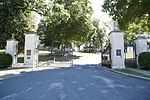Gundry Sanitarium

The Gundry Sanitarium, also known variously as the Relay Sanitarium, Lewis Gundry Sanitarium, Gundry Hospital, and Conrad Sanitarium, was a medical institution established in 1900 in Southwest Baltimore City, Maryland. The building, originally named "Athol," was constructed in 1880 as a residence for Charles J. Baker and designed by Baltimore architect T. Buckler Ghequier.It was purchased in 1900 by Dr Alfred Gundry as a private sanitarium for the "care of nervous disorders of women that required treatment and rest away from home." It continued in existence as a private sanitarium until 1997. It was purchased by the city in 2006 for historic preservation, but it burned down on September 27, 2021, prior to any improvements.
Excerpt from the Wikipedia article Gundry Sanitarium (License: CC BY-SA 3.0, Authors, Images).Gundry Sanitarium
Atholgate Lane, Baltimore
Geographical coordinates (GPS) Address Nearby Places Show on map
Geographical coordinates (GPS)
| Latitude | Longitude |
|---|---|
| N 39.284289 ° | E -76.697829 ° |
Address
Former Gundry/Glass Hospital (Grand Gundry Sanitarium)
Atholgate Lane 2
21229 Baltimore
Maryland, United States
Open on Google Maps






